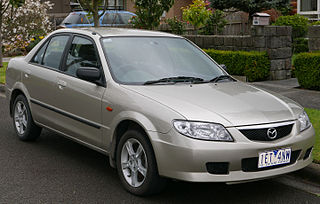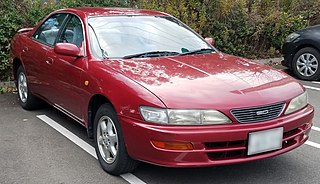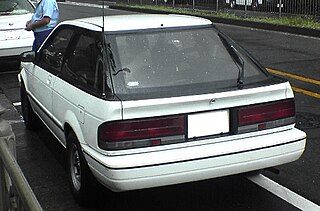
The Honda Integra, sold in North America as the Acura Integra, is an automobile produced by the Japanese company Honda from 1985 until 2006, and then since 2021. It succeeded the Quint as a more luxurious and sport-oriented derivative of the Civic. The Integra was one of the launch models for Acura in the US in 1986 alongside the Acura Legend. Throughout its production run, the Integra was highly regarded for its handling and performance. The 1995–2001 Integra Type R is widely regarded as one of the best front-wheel-drive cars of all time.

The Mazda Capella, also known as the 626 in Europe, North America and Southeast Asia, is a mid-size car that was manufactured by Mazda from 1970 until 2002. Sold in the Japanese domestic market under the Capella name, the vehicle was also commonly known in other major markets as the Mazda 626. Ford, Mazda's partner at the time, also used the Capella platform to create the Ford Telstar and Ford Probe. 4,345,279 of the 626 and Telstar models were sold worldwide.

The Mazda Luce is an executive car that was produced by Mazda in Japan from 1966 until 1991. It was widely exported as the Mazda 929 from 1973 to 1991 as Mazda's largest sedan. Later generations were installed with luxury items and interiors as the Luce became the flagship offering. The Luce was replaced by the Sentia in 1991 which was also exported under the 929 nameplate.

The Mazda Familia, also marketed prominently as the Mazda 323, Mazda Protegé and Mazda Allegro, is a small family car that was manufactured by Mazda between 1963 and 2003. The Familia line was replaced by the Mazda3/Axela for 2004.

The MS-8 is a luxury car that was produced and sold by from March, 1992 through 1997. The car is a replacement to the Mazda Persona and Eunos 300. Just like the Persona is based on the 1987-1991 Mazda Capella, the MS-8 is based on the 1991-1997 Mazda Cronos. The MS-8 had the same dimensions as the Cronos, and the ɛ̃fini MS-6, sharing the 2.5 L V6 engine. The width, length, and engine displacement dimensions have particular significance in Japan, due to dimension regulations, where Japanese consumers pay an additional annual tax for larger vehicles, and obligate them to pay more annual road tax.

The Mazda Sentia is a mid-size rear wheel drive luxury car that was sold by Mazda in Japan from 1991 to 1999 over two generations. It replaced the Mazda Luce nameplate on the Mazda H platform, and continued the tradition of being Mazda's largest flagship sedan, which had been in production since the late 1960s.

The Toyota Sprinter is a compact car manufactured by Toyota as a variant of the Toyota Corolla. Exclusively sold in the Japanese domestic market, the Sprinter was aimed to be sportier than its Corolla sibling and also using different sheet metal mostly on the C-pillar. The Sprinter was sold exclusively at the Toyota Auto Store while the Corolla was sold at the eponymous Toyota Corolla Store, which focused on economical cars compared to the more upmarket Vista store.

The Nissan Laurel is a front-engine, rear-drive two- and four-door sedan manufactured and marketed by Nissan from 1969 to 2002. Introduced in 1968 as a new model positioned above the 1968 Datsun Bluebird 510, the Laurel offered the luxury of the Nissan Cedric 130 in a smaller size. In Japan, the Laurel was marketed solely as a Nissan model, rather than a Datsun model.

The Toyota Chaser is a mid-size car produced by Toyota in Japan. Most Chasers are four-door sedans and hardtop sedans; a two-door hardtop coupé was available on the first generation only. It was introduced on the 1976 Toyota Corona Mark II platform, and was sold new by Toyota at Toyota Vista Store dealerships only in Japan, together with the Toyota Cresta.

The Nissan Cedric is a large automobile produced by Nissan since 1960. It was developed to provide upscale transportation, competing with the Prince Skyline and Gloria which were later merged into the Nissan family. In later years, the Nissan Skyline was positioned as a sports sedan/coupe, whereas the Nissan Gloria was turned into a sporty version of the Cedric.

The Toyota Carina is an automobile which was manufactured by Toyota from December 1970 to December 2001. It was introduced as a sedan counterpart of the Celica, with which it originally shared a platform. Later, it was realigned to the Corona platform, but retained its performance image, with distinctive bodywork and interior — aimed at the youth market and remaining exclusive to Japanese Toyota dealerships Toyota Store. It was replaced in Japan by the Toyota Allion in 2001 and succeeded in Europe by the Toyota Avensis.

The Toyota Crown is an automobile which has been produced by Toyota in Japan since 1955. It is primarily a line of mid-size luxury cars that is marketed as an upmarket offering in the Toyota lineup.

The Nissan Leopard is a line of sport/luxury cars built by Japanese carmaker Nissan. The Leopard began life in 1980 and was discontinued in 1999. The Leopard were initially based on the Japanese market Nissan Skyline and Nissan Laurel, then later based on the chassis of their Nissan Cedric and Nissan Gloria contemporaries and were rear wheel drive. Final versions were the contributing factors to Nissan's Infiniti M and J products.

The Toyota Sprinter Marino is a four-door hardtop version of the Toyota Sprinter sedan produced between 1992 and 1998 for sale in Japan. The Toyota Corolla Ceres is a slightly restyled version of the Sprinter Marino, as was common practice by Japanese automakers in the 1980s and 1990s.

The Corolla E30/E50 was the third generation of cars sold by Toyota under the Corolla nameplate. It was built from August 1974 to July 1981 and marked Toyota's greatest growth in the United States in the wake of the fuel crisis. In addition to its sister model, the Sprinter, there was a redesigned-body version built by Toyota affiliate Daihatsu, called the Daihatsu Charmant. While there were certain fourth-generation models with a longer model life, this generation, when considered as a whole, was the longest-lived one, possibly due to the worldwide recession in the 1970s. A large range of cars was built using this chassis, including Corollas, Sprinters, Daihatsu, and the sporty Levin and Trueno models with the DOHC motor, with a fuel injection upgrade added to Japanese Levin models in January 1977.

The Corolla E70 was the fourth generation of cars sold by Toyota under the Corolla nameplate.

The Toyota Carina ED is a compact car manufactured by Japanese automaker Toyota in 1985 as a companion to the 1984 Carina sedan. It was positioned as the four-door Celica, with a similar focus on luxury found on larger Toyota hardtop sedans, like the Toyota Crown and the Toyota Cresta. It was the counterpart of the Corona EXiV. Its design sought to emulate the hardtop four-door coupé styling of large American and European sedans, resulting in a small, low cabin with longer front and rear ends. The ED's B-pillar stood up in the middle with no purpose other than to hinge the rear door on; it was not attached to the roof side of the cabin. The ED achieved huge sales in Japan, and other Japanese manufacturers introduced the Mazda Persona, Nissan Presea, and Mitsubishi Emeraude around the same time. "ED" is the initials of "Exciting" and "Dressy". When the Carina ED was discontinued, the Toyota Brevis appeared for the market segment served by the Carina ED.

The fourth-generation Honda Civic is a Japanese sub-compact automobile. It was produced by Honda from 1987 until 1991 with the wagon continuing in production in some markets until 1996. The suspension had a new double-wishbone suspension in the front and an independent suspension in the rear, the wheelbase was increased to 250 centimetres (98 in) from that of the third-generation Civic, and the body was redesigned with a lower hood line and more glass, resulting in less drag. The redesigned Civic was introduced in 1987 for the 1988 model year. The fourth-generation Civic would be available in three variants; 3-door hatchback, 4-door sedan and 5-door wagon with various trim levels offered in each variant.

The first generation Subaru Legacy is a mid-size family car / wagon developed by Fuji Heavy Industries. The Legacy was an all new model, and was considered a notable departure from Subaru products in the past.

The Mazda Étude is a three-door hatchback coupé version of the fifth-generation Familia that was only ever marketed by Mazda in Japan, from 1987 to 1989. The name was also later used in South Africa for the sixth generation Familia.





















